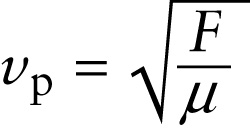Speed of a transverse wave on a rope (13-10)
Question 1 of 3
Question
Propagation speed of a transverse wave on a rope
{"title":"Propagation speed of a transverse wave on a rope","description":"Correct!","type":"correct","color":"#99CCFF","code":"[{\"shape\":\"poly\",\"coords\":\"82,133\"},{\"shape\":\"rect\",\"coords\":\"10,16,12,16\"},{\"shape\":\"rect\",\"coords\":\"3,51,28,85\"}]"} {"title":"Tension in the rope","description":"Wrong","type":"incorrect","color":"#993300","code":"[{\"shape\":\"rect\",\"coords\":\"190,9,229,57\"}]"} {"title":"Mass per unit length of the rope","description":"Wrong","type":"incorrect","color":"#333300","code":"[{\"shape\":\"rect\",\"coords\":\"180,79,219,128\"}]"}Review
The inertia of the rope depends on its mass per unit length or linear mass density (SI units kg/m), which we denote by the Greek letter μ (“mu”). If the rope is uniform, μ is just equal to the mass of the rope divided by its length. A thick rope has more mass per unit length than does a piece of ordinary string and so has more inertia. As the mass per unit length of a rope increases, the wave propagation speed decreases.
If we take both restoring force and inertia into account, we find that the propagation speed vp of a transverse wave on a rope is

